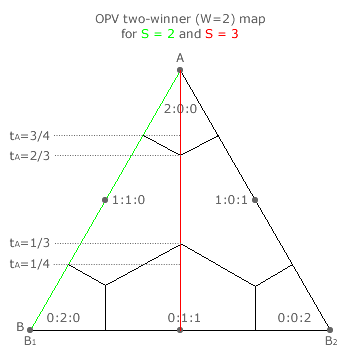Evaluations: Party Cloning 1
The Downside of Optimal Proportionality
If a multiple-winner party-proportional voting system is required, what could be better than an Optimally Proportional Voting (OPV) one? Given that the number of elected representatives is invariably much smaller than the numbers of electors to be represented, perfect proportionality is very rarely possible. By definition, an OPV system is indeed the best that can be achieved in practice. Unfortunately however, OPV is susceptible to manipulation by parties engaging in strategic nominations. Here, it is the party itself that is cloned rather than just candidates.
Suppose that a party believes it can achieve two seats rather than just one by cloning itself. All it needs to do is to nominate two (clone) parties with each issuing its own complete party list. Its two hopeful winners should each be ranked top on their respective party list and, if desired, superfluous candidates may be added underneath to fill up the list. Even assuming that the combined vote share for the two clone parties is identical to that for the non-cloned original, such party cloning can indeed sometimes be successful in gaining more seats.

As an example, consider the case of a party-list OPV election with two winners (W = 2). Initially, there are two parties A and B but, after cloning, B becomes clone parties B1 and B2. The three-party map (S = 3) for A, B1 and B2 shown opposite also includes the two-party map (S = 2) for A and B along the left-hand edge of the triangle. For clarity, this two-party map is displayed as a green line.
As the clone parties B1 and B2 are identical, voters are just as likely to vote for B1 as for B2. Hence, B1 and B2 have the same share of vote; namely half the vote share achieved by party B. Given this equal tally share between B1 and B2, the red line on the three-party map highlights all the possible election outcomes for this constrained three-party scenario. The relative tally share for party A (tA) is the same whether A competes against B1 and B2 or just B.
If the tally share for A is above three quarters (tA > 3/4), notice that party A wins both seats whether B clones itself or not. Also, if this tally share is below one quarter (tA < 1/4), then party B wins two seats without cloning. With cloning, it still wins the two seats; one each for B1 and B2. Further, for a tally share between one third and two thirds (1/3 > tA > 2/3) party A wins one seat and party B the other seat. With cloning, either B1 or B2 wins this B seat following a random tie break.
However, for the remaining two ranges of tally share for party A (highlighted in white) cloning by party B succeeds in altering the election outcome. In the upper range (2/3 > tA > 3/4) party B wins one seat without cloning but none with cloning. This is clearly a case of self-harm. In the lower range (1/4 > tA > 1/3) party B again wins one seat without cloning but now two seats with cloning. This is equally clearly a case of gaining an unfair advantage through the strategic nomination of clone parties.

In the tally share threshold figure opposite, the pre-cloning green line and the post-cloning red line are redrawn as parallel lines of the same length (by appropriate scaling). The two ranges of tally share for party A that give different seat shares after cloning by party B are again highlighted in white. For each of the three map domains, its seat share (A:B) for the two parties is stated inside it.
The tally share threshold for party A to gain two seats drops (from 3/4 to 2/3) when party B clones itself. However, to gain one seat when party B attempts cloning, party A must increase its tally share threshold (from 1/4 to 1/3). Therefore, cloning is harmful to the cloning party when it reduces the requisite tally share threshold for the other party but is successful when this threshold is raised. Although an OPV system inherently produces the fairest party-proportional outcomes for sincerely nominated parties, it can nevertheless be unfairly manipulated by parties attempting to gain unjust advantages through strategic nominations.
Proceed to next page > Evaluations: Party Cloning 2
Return to previous page > Evaluations: Optimality 4
